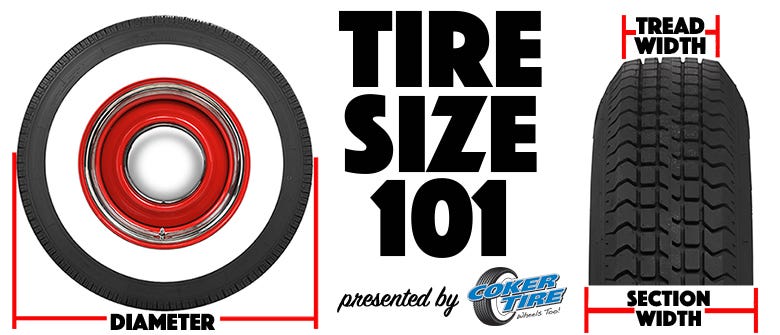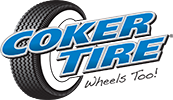Tire Size 101 | Understanding Vintage Tire Sizes


Tire sizing is a bit of a mystery to some car enthusiasts, as standards have changed over the past 100 years of tire manufacturing. The result is multiple versions of sizing terminology. There are three common types of tire sizing from the 1920’s through the modern era—numeric, alphanumeric and P-metric. Uncommon forms of tire sizing are used for high pressure tires (Brass Era), race tires, vintage metric tires and certain types of off-road truck tires. We'll cover it all here, and give you tips on how to find the right tire for your classic car, hot rod, vintage truck, or whatever you're working on.
High Pressure Sizing - 1900's to 1920's
When pneumatic tires hit the mainstream in the 1900's, tires were inflated to 65 psi and higher, in order to hold the tire to the rim properly. We now refer to these tires, such as the Goodrich Silvertownd Cord (pictured), Firestone Non Skid and others, as "High Pressure" tires. Whether it's a clincher rim, lock ring style or other type of Brass Era rim, these high pressure tires feature an early sizing style.
A common size for a high pressure tire is 30 x 3. The "30" in the sizing refers to the tire's overall diameter and the "3" is an approximation of the tire's section width--simple enough, right? The only thing left out of the size is the rim size. To determine the rim size on high pressure tires, we double the section width number (3 + 3 = 6) and then subtract it from the diameter (30 - 6 = 24 inches).
Another example is 34 x 4 1/2 (these are always written out in fraction form, not decimals). In this example, our quick math tells us that it fits a 25-inch rim. High pressure tires are common on vehicles built before 1927. They would eventually be phased out by Balloon tires and drop center rims, which used less air pressure.
Numeric Sizing - 1920's to 1960's
Numeric sizing is most common on bias ply tires manufactured from the late 1920’s through the late 1960’s. This started with the tires that were marketed as Balloon tires, due to their lower air pressure and soft ride. Early Balloon tires, like the ones that were optional on later Ford Model T's, changed the automotive industry.
When this new style tire and wheel hit the market, it had a new sizing structure that we now refer to as numerical sizing. It leads off with the tire's section width, in inches and then features its rim diameter (ex. 4.50-21, sometimes referred to as 4.50x21). In the case of a 1930 or 1931 Ford Model A, the original tire size was 4.75-19. Through the years, popular tire sizes were combined, resulting in the current availability of 475/500-19 tires. This combination of similar sizes mostly applies to tires produced in the 1920's and 1930's.
Many of the early Numeric sized tires feature nearly a 100 percent aspect ratio, meaning that the sidewall section height is nearly equal to the section width of the tire. In those cases, you can get a rough estimate of the tire's overall diameter by doubling the section width and adding the rim diameter. 5.25-21 tells us that 5.25 + 5.25 + 21 = 31.50, which is the exact dimension of the tire's overall diameter. This math doesn't always add up to the exact number, but it gives you a close estimate.
Going in the 1930's the most common tire size was 6.00-16. Again the 6.00 refers to the section width of the tire, resulting in a tread width of about 4-1/2 inches. After World War II, the automotive world began changing, with futuristic designs, creature comforts and more powerful engines.
As time went on, American cars gradually transitioned into smaller wheel diameters, while increasing tire and wheel width. This provided better performance, as the wider contact patch and shorter sidewall helped with traction and stability.
As a general rule of thumb, tires from the 1930's through the 1950's feature a 90 percent aspect ratio, meaning that the sidewall section height is 90 percent of the tire's section width. Any tire size that ends with a zero, such as 6.70-15 or 7.10-15 featured this approximate high percent aspect ratio. By the mid 1960's, tire sizes transformed again. Any bias ply tire ending in the number five, such as 6.95-14, 7.75-15, etc. featured an 80 to 84 percent aspect ratio.
We continue to use numeric sizing in most of our bias ply tires, as well as our bias look radials. For the radial tires, we simply add the letter "R" in place of the hyphen (ex. 6.70R15). You may notice that some numeric sizes are listed in vehicle reference books with or without a decimal point (ex. 600-16), or with an "X" instead of a hyphen (ex. 4.75x21). We try to keep the name formatting consistent with our product listings, but you may notice variences elsewhere.
Alphanumeric Sizing - 1960's to 1970's
Alphanumeric sizing became common in 1967, and was the industry standard only a few years later. This type of sizing takes the guess work out of the aspect ratio, but it creates some guess work on the tire’s overall width.
The size starts with a letter, which is the tire's load range. The higher the letter, the larger the tire. A78-13 is an example of a very small tire for an economy car, and L78-15 is an example of a large tire for a Cadillac. The two-digit number after the load range rating is the aspect ratio. The two-digit number at the end is wheel diameter.
The introduction of alphanumeric tires was also the introduction of smaller aspect ratios, and shorter sidewalls. 78 series was common, but 70 series and 60 series came shortly after. The muscle car era saw creative usage of alphanumeric tires, including the Firestone Wide Oval. It was available in redline originally and then later in raised white letter. Popular sizes for the Firestone Wide Oval was F70-14 and G70-15.
Aftermarket tire companies, such as Pro Trac tires offered custom alphanumeric sizes, such as N50-15, an enormous tire that was typically used on the back of modified muscle cars. Radial tires were introduced to American markets in the late 1960's and became original equipment offerings in the mid 1970's. The alphanumeric sizing remained, but an "R" was added after the load rating (ex. LR78-15).
P-Metric Sizing - 1970's to Current
The most current form of tire sizing is P-Metric. This sizing nomenclature can be confusing because the section width is listed in millimeters, the aspect ratio is listed as a percentage and the wheel diameter is most often listed in inches. For example, a P205/75R15 tire features a section width of 205 millimeters, and a sidewall that is 75 percent of that width. The “R” designates radial construction and the 15 indicates a 15-inch wheel diameter. If a "B" or a hyphen takes the place of the "R", it is a bias ply tire. This has been the industry standard in the United States since the 1970's, but the idea for this metric size came a couple decades earlier in Europe.
British sports cars featured tires such as 165R15, dating back to the 1950's and 1960's. You'll notice that there is no aspect ratio designation. When a size is listed with only the section width and rim diameter, you are to assume that it features an 80 percent aspect ratio. So, you could read it as 165/80R15--some tire manufacturers adapted this style to be more consistent with its other tire sizes. Some foreign cars use metric wheels, so it's common to see a size like 220/55VR390 in our Michelin TRX product line. If you see two letters in a P-Metric size, like "VR" or "HR", the additional letter is the speed rating.
P-Metric radial tires are a common replacement for original bias ply tires. In the case of 1950's classics, we most often suggest a 205/75R15 for cars that originally came with a 6.70-15 bias ply tire. We also use 205/75R15 radials as a cross reference to original 7.75-15 Corvette tires. If you have further questions about tire size, we're just a phone call away at 866-516-3215.


Other Sizing Styles - Race Tires, Truck Tires and More!
Sizing that does not fit into the four common styles can also be confusing. Some, however are very straight forward. Take drag racing tires--the actual dimensions (tread width, overall diameter and wheel diameter) are listed in inches, making it pretty straight forward. The only issue comes with Cheater Slicks as the section width is listed, instead of the tread width. Drag radials feature P-Metric radial sizing. Other additional sizing styles are off-road tires. Again, most of them are straight forward with the dimensions listed in inches.











